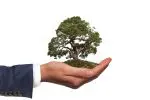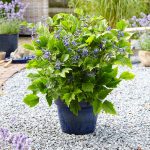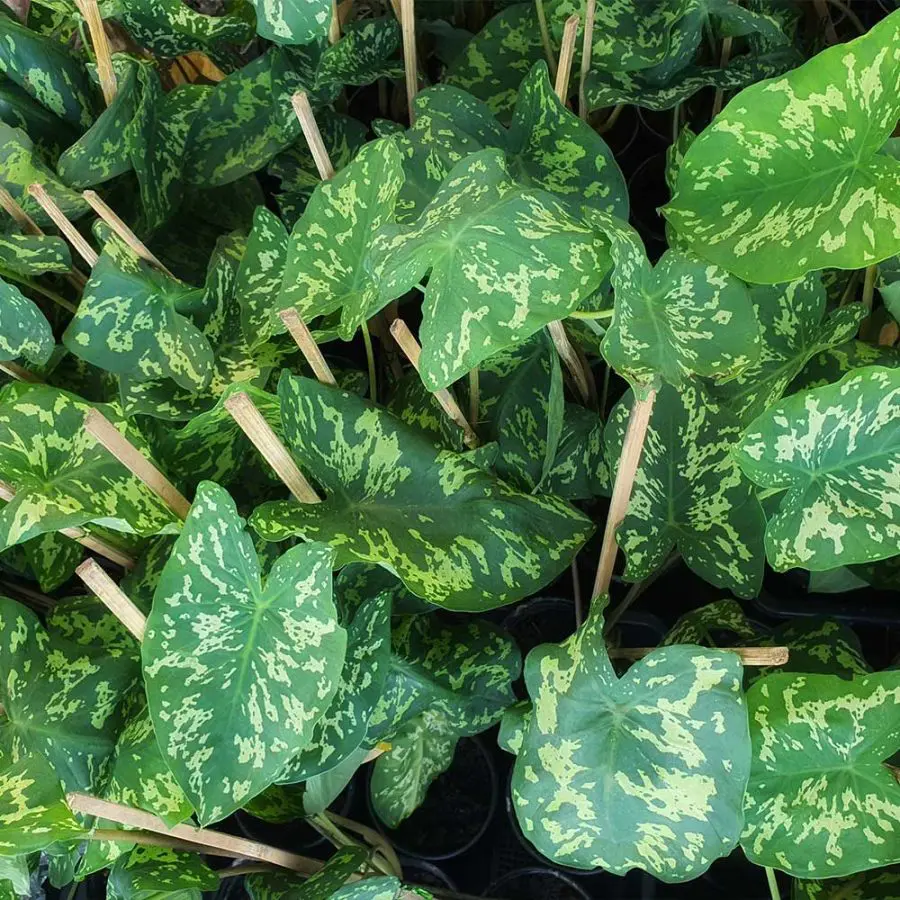This post contains affiliate links. If you buy something from one of our links we may earn a commission. Thanks
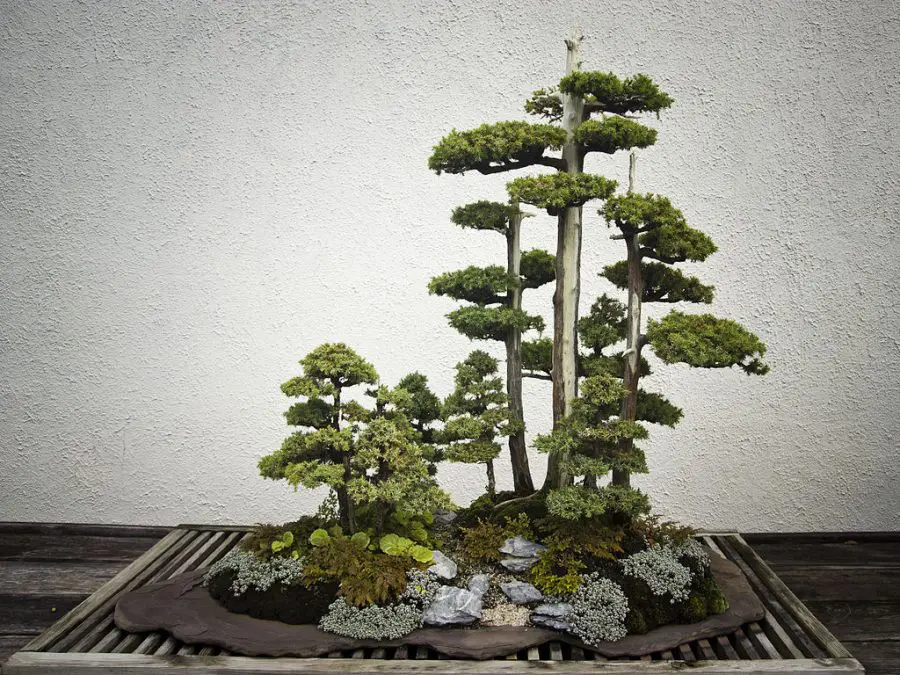
Dive into the fascinating world of Penjing vs Bonsai with our friendly guide!
Discover 7 intriguing differences between these captivating miniature tree art forms. Join us on this journey!
Penjing vs Bonsai differences primarily lie in their origins and style. Penjing originates from China and often features miniature landscapes, including rocks and water features. Bonsai, from Japan, usually focuses on individual trees and shrubs pruned to create an aesthetic miniaturized plant. Both art forms share the goal of creating miniature natural scenes but have distinct cultural and stylistic approaches.
Hey there, fellow tree enthusiasts! Today, we’re going to explore the enchanting realms of Penjing and Bonsai.
You might have heard of these two intriguing art forms before, but do you know the differences between them?
As we dive into the world of Penjing vs Bonsai, we’ll uncover 7 fascinating distinctions that set these miniature marvels apart.
So, grab a cup of tea, find a comfy spot, and let’s embark on this exciting journey together!
Penjing vs Bonsai: 7 Intriguing Differences
Hey there, nature lovers and art aficionados! We’re about to embark on a captivating journey into the mesmerizing worlds of Penjing and Bonsai.
These ancient, miniature tree art forms have captured the imaginations of people around the globe, but they’re more distinct than you might think.
In this post, we’ll uncover 7 intriguing differences between these amazing art forms.
So, kick back, relax, and let’s dive into the fascinating realms of Penjing and Bonsai together!
A Glimpse into Penjing and Bonsai
Before we delve into the nitty-gritty, let’s take a moment to appreciate Penjing and Bonsai as unique art forms.
Penjing, hailing from China, is all about crafting miniature landscapes with trees, rocks, and water.
On the other hand, Bonsai, which originated in Japan, zeroes in on cultivating and shaping individual trees to create harmonious miniatures.
Both arts require immense patience, skill, and a deep connection to nature.
Why Differences Matter
You might be wondering why it’s important to understand the distinctions between Penjing and Bonsai.
Well, recognizing these differences allows us to appreciate the cultural, historical, and artistic nuances that make each form special.
By exploring these contrasts, we can develop a deeper appreciation for the artists’ creativity, as well as the underlying philosophies that guide their work.
What to Expect in this Blog Post
In this article about Penjing and Bonsai, we’ll take you on a guided tour of the 7 most interesting differences between these two captivating arts.
We’ll delve into their origins, aesthetic principles, techniques, pot styles, tree species, and philosophical foundations.
So, buckle up and get ready to immerse yourself in the world of miniature tree artistry!
Penjing vs Bonsai Origin and History
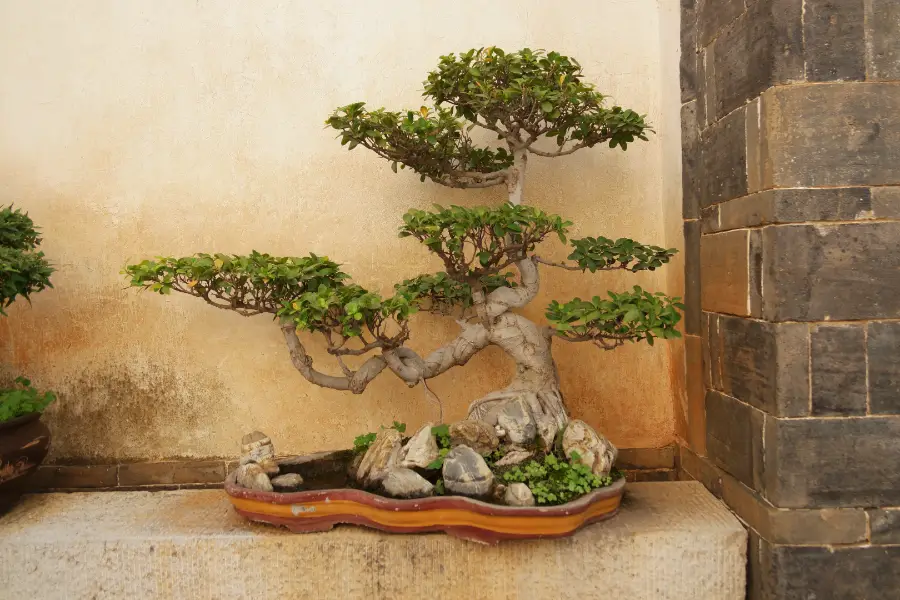
Alright, history buffs and tree lovers, let’s take a step back in time and explore the fascinating origins of Penjing and Bonsai!
These two incredible art forms have deep historical roots, and understanding their beginnings is crucial to appreciating their uniqueness.
So, let’s fire up our time machines and journey through the ages, uncovering the stories and cultural influences that gave birth to these mesmerizing miniature tree landscapes.
Penjing: The Chinese Progenitor
Let’s kick things off with Penjing, the granddaddy of miniature tree art.
With a history spanning over a thousand years, Penjing is deeply rooted in Chinese culture.
It all began with ancient Chinese aristocrats and scholars who found inspiration in nature and sought to recreate its beauty in their own miniature landscapes, complete with trees, rocks, and water features.
From China to Japan
It’s hard to imagine the world of Bonsai without its Penjing predecessor!
As the cultural exchange between China and Japan blossomed, the art of Penjing made its way to the Land of the Rising Sun.
Japanese artists embraced the practice, adapting it to their own aesthetics and cultural sensibilities.
Thus, the stage was set for the emergence of Bonsai.
Bonsai: The Japanese Evolution
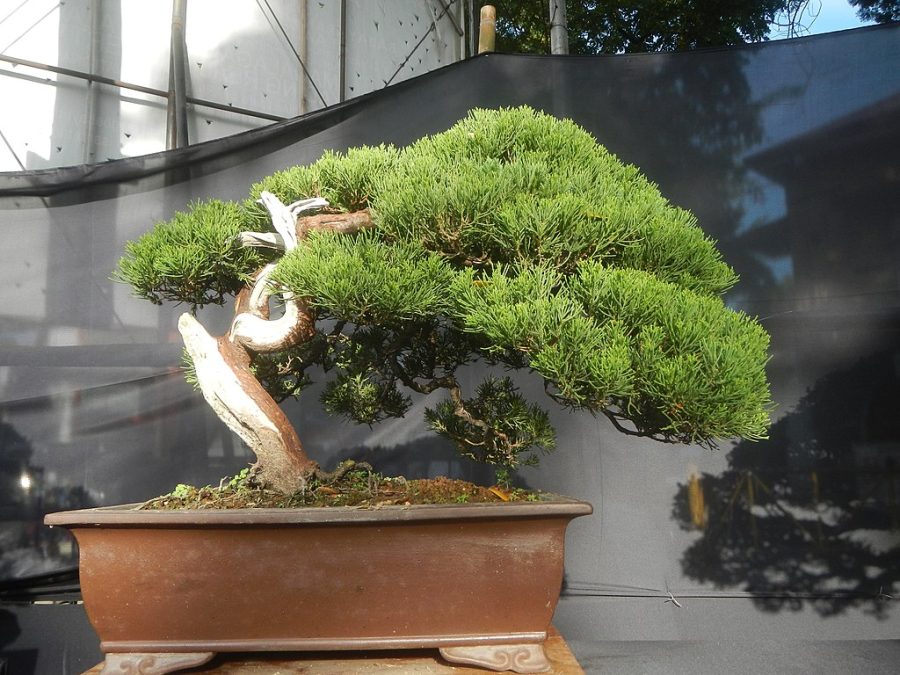
A New Art Form Takes Root
Once the seeds of Penjing were planted in Japan, they began to grow into the distinct art form we know today as Bonsai.
Around 700 years ago, Japanese artists started to put their own spin on the practice, shifting the focus from elaborate landscapes to the cultivation and shaping of individual trees.
The result was a new, captivating art form that highlighted the beauty and harmony found in nature.
Bonsai’s Journey in Japan
Over the centuries, Bonsai continued to evolve in Japan, with various styles and techniques emerging to suit different tastes and preferences.
Influenced by Zen Buddhism, Japanese Bonsai artists began to emphasize the importance of balance and simplicity in their work.
This evolution transformed Bonsai into an art form that not only showcased the beauty of miniature trees but also expressed deeper philosophical concepts.
Landscape Elements
Now that we’ve explored the origins of Penjing and Bonsai, let’s dive into one of the most striking differences between them: landscape elements!
You’ll quickly notice that these two miniature tree art forms have their unique ways of capturing nature’s essence.
From the use of rocks and water to the focus on individual trees, the landscape elements in Penjing and Bonsai each tell a captivating story.
So, let’s venture into these miniature worlds and discover how they bring nature’s beauty to life in their own special ways.
Penjing: Miniature Landscapes Unfold
Rockin’ the Scenery
One of the most striking features of Penjing is the use of rocks to create mesmerizing miniature landscapes.
Artists meticulously select and arrange rocks to emulate natural formations, like mountains, cliffs, or valleys.
These rocky masterpieces add depth, texture, and a sense of grandeur to the scenes.
A Splash of Water
Another key element in Penjing is water, which often plays a central role in the composition.
Artists might use real or simulated water features, like rivers, lakes, or waterfalls, to enhance the landscape’s atmosphere and bring a sense of tranquility to their creations.
A Touch of Whimsy with Figurines
To further enliven their miniature landscapes, Penjing artists often incorporate tiny figurines, such as people, animals, or even buildings.
These charming details add a touch of whimsy and storytelling to the scenes, inviting viewers to imagine the lives and adventures taking place within the tiny worlds.
Bonsai: The Beauty of Individual Trees
In contrast to Penjing’s focus on entire landscapes, Bonsai is all about the trees themselves.
Bonsai artists meticulously nurture, prune, and shape individual trees to create harmonious and balanced compositions.
By highlighting the tree’s natural beauty and character, Bonsai artists showcase the essence of nature in a single, compact form.
This focus on individual trees allows Bonsai to convey a sense of simplicity and elegance, captivating viewers with its serene, minimalist aesthetic.
Aesthetics
As we continue our journey through the world of Penjing and Bonsai, it’s time to talk about aesthetics!
While both art forms share a deep love for nature, their visual styles are quite distinct.
From the natural, free-flowing appearance of Penjing to the clean lines and balance of Bonsai, each art form has its own unique beauty.
So, let’s take a closer look at the captivating aesthetics of Penjing and Bonsai and discover how they express nature’s wonder in their own extraordinary ways.
Penjing: Embracing Nature’s Flow
When it comes to Penjing, the aesthetics are all about capturing the natural, organic essence of landscapes.
Penjing artists often let their trees and plants grow more freely, embracing their inherent shapes and characteristics.
This free-flowing approach lends a sense of spontaneity and wildness to the compositions, giving viewers the impression that they’re looking at a living, breathing slice of nature.
It’s as if you’ve stumbled upon a magical, miniature world, just waiting to be explored!
Bonsai: The Art of Balance and Harmony
In the realm of Bonsai, aesthetics take a slightly different path.
Bonsai artists focus on clean lines, balance, and harmony, meticulously pruning and shaping their trees to create elegant, minimalist compositions.
The goal is to showcase the tree’s natural beauty while maintaining a sense of order and tranquility.
This approach imbues Bonsai with a serene, meditative quality that invites viewers to pause, reflect, and appreciate the subtle harmony between man and nature.
Pruning Techniques
Now that we’ve admired the aesthetics of Penjing and Bonsai, let’s chat about the techniques behind these amazing art forms!
You might be surprised to learn that the pruning methods used in Penjing and Bonsai are quite distinct, shaping their trees in fascinatingly different ways.
From wiring to weights, these techniques are the heart and soul of each art form, helping to create the captivating beauty we see in their miniature landscapes.
So, let’s roll up our sleeves and dig into the world of Penjing and Bonsai pruning techniques!
Penjing: A Toolbox of Techniques
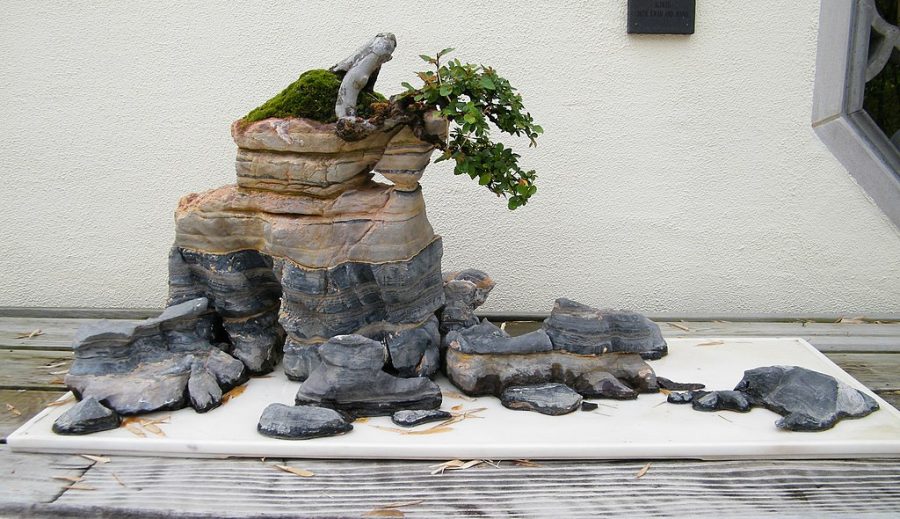
Wired for Perfection
When it comes to shaping their miniature trees, Penjing artists employ a variety of techniques to achieve their desired results.
One such method is the use of wire.
Artists carefully wrap wires around the branches and trunks of their trees, gradually bending and shaping them to create natural looking curves and angles.
Over time, the tree adapts to its new form, and the wire can be removed.
Weighing in on Tree Shaping
Another technique unique to Penjing is the use of weights.
Artists attach small weights to branches or trunks to gently pull them into the desired position.
This method allows for more gradual shaping and often results in a more organic appearance, as the tree slowly responds to the subtle pressure.
Bracing for Beauty
Wooden braces are yet another tool in the Penjing artist’s arsenal.
These braces are strategically placed to support branches or trunks in specific positions, helping to mold the tree’s overall form.
Over time, the tree becomes accustomed to the new shape, and the braces can be removed.
Bonsai: The Art of Pruning and Wiring
In the world of Bonsai, artists primarily rely on two techniques to sculpt their trees: selective pruning and wiring.
Selective pruning involves carefully removing branches and leaves to achieve a balanced, harmonious composition.
This method not only helps shape the tree but also encourages healthy growth and optimal foliage density.
Wiring, like in Penjing, is used to bend and shape branches and trunks into the desired form.
Bonsai artists typically use copper or aluminum wire to manipulate their trees, and over time, the tree conforms to the new shape.
When the tree has adapted to its new form, the wire is removed, and the tree maintains its elegant, harmonious appearance.
Pot Styles
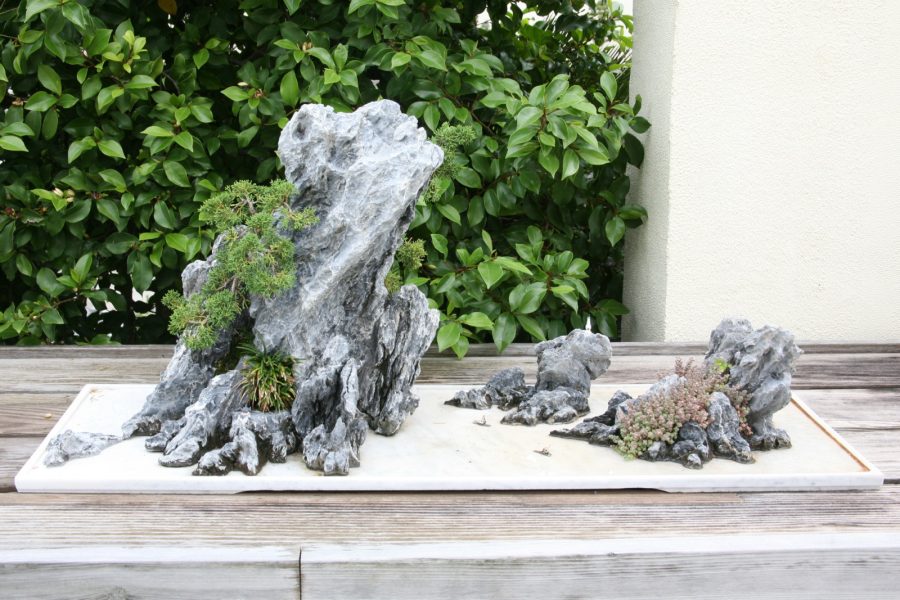
As we continue our exploration of Penjing and Bonsai, let’s not forget one of the most important aspects of these art forms: the pots!
The pots in which these miniature trees reside play a crucial role in shaping the overall appearance and aesthetic of each composition.
From intricate designs to simple elegance, the pot styles used in Penjing and Bonsai are as diverse and captivating as the trees themselves.
So, let’s take a moment to appreciate the craftsmanship and artistry behind these essential components of Penjing and Bonsai!
Penjing: Embracing the Irregular
In the world of Penjing, the pots used to display these miniature landscapes are often shallow and irregularly shaped.
This choice of pot style complements the free-flowing, organic nature of Penjing compositions.
The irregular shapes and intricate designs of the pots add to the overall visual interest, enhancing the sense of spontaneity and natural beauty.
These pots not only house the trees, rocks, and water features but also serve as a crucial element of artistic expression in Penjing.
Bonsai: The Elegance of Uniformity
By contrast, Bonsai pots tend to be deeper and more uniform in shape.
This choice of pot style aligns with the clean lines and balanced aesthetics that characterize Bonsai compositions.
The pots are often simple, with minimal ornamentation, allowing the focus to remain on the harmonious relationship between the tree and the pot.
By using deeper and more uniform pots, Bonsai artists create a sense of stability and tranquility, further emphasizing the serene beauty of their miniature trees.
Tree Species
As we near the end of our fascinating journey through the worlds of Penjing and Bonsai, let’s take a closer look at the stars of the show: the tree species!
Both Penjing and Bonsai feature a wide variety of tree species, each with its own unique characteristics, growth habits, and visual appeal.
Some species are more common in one art form than the other, which further adds to their distinctiveness.
So, let’s dive into the beautiful diversity of tree species in Penjing and Bonsai and discover what makes them such captivating subjects for these ancient art forms.
Penjing: A Celebration of Chinese Trees
Elegant Elms
One of the most common tree species found in Penjing is the Chinese elm (Ulmus parvifolia).
With its delicate leaves and strong, flexible branches, the Chinese elm lends itself well to the shaping and styling techniques used in Penjing.
Its adaptability and resilience make it a favorite among artists.
The Juniper Journey
Junipers are another popular choice for Penjing compositions.
With their dense foliage and hardy nature, junipers offer a wide range of styling options for Penjing artists.
They can be shaped into a variety of forms, from windswept to cascading, making them a versatile addition to any Penjing landscape.
The Cypress Connection
Cypress trees, such as the Chinese or Hinoki cypress, are also commonly used in Penjing.
Their tall, slender trunks and delicate foliage create an elegant, natural appearance that works beautifully in Penjing’s miniature landscapes.
Cypress trees are also known for their pleasant fragrance, adding another sensory dimension to Penjing compositions.
Bonsai: Showcasing Japanese Tree Species
The Magic of Maples
Japanese maple (Acer palmatum) is a classic choice for Bonsai artists.
With their delicate, intricately shaped leaves and stunning seasonal color changes, Japanese maples bring a touch of elegance and beauty to any Bonsai composition.
They’re especially well-suited to Bonsai’s emphasis on balance and harmony.
The Power of Pine
Pine trees, such as the Japanese black pine (Pinus thunbergii) or the Scots pine (Pinus sylvestris), are another popular choice for Bonsai artists.
With their striking needle-like foliage and rugged bark, pines evoke a sense of strength and resilience.
They’re particularly well-suited to Bonsai’s clean lines and minimalist aesthetic.
Amazing Azaleas
Azaleas (Rhododendron spp.) are a favorite among Bonsai enthusiasts for their stunning blooms and vibrant colors.
These flowering shrubs offer a splash of color to Bonsai compositions, adding visual interest and contrast.
The combination of their delicate flowers and the artful shaping of their branches makes azaleas an eye-catching choice for Bonsai.
Philosophical Underpinnings
As we wrap up our journey through the captivating worlds of Penjing and Bonsai, it’s important to recognize the philosophical underpinnings that shape and inspire these art forms.
Both Penjing and Bonsai are deeply rooted in the cultural and spiritual traditions of their respective countries, with each reflecting unique perspectives on the relationship between humans, nature, and the cosmos.
So, let’s take a moment to ponder the profound philosophies that guide these ancient art forms and give them such enduring beauty and meaning.
Penjing: A Tapestry of Chinese Philosophies
The Taoist Touch
At the heart of Penjing lies the influence of Taoism, an ancient Chinese philosophy centered on living in harmony with the Tao, or the natural order of the universe.
Penjing artists seek to capture the essence of nature in their miniature landscapes, reflecting the Taoist belief in the interconnectedness of all things and the importance of balance and harmony.
Confucianism’s Contribution
Confucianism, another key Chinese philosophy, also plays a role in Penjing’s development.
Confucianism emphasizes the importance of rituals, ethics, and social order.
In Penjing, this is expressed through the meticulous care and attention given to the trees and landscapes, as well as the respect for the natural world and its ability to teach and inspire.
The Buddhist Connection
Buddhism, which has a long history in China, also informs the practice of Penjing.
Buddhist principles, such as mindfulness, detachment, and the impermanence of life, are reflected in the careful cultivation and shaping of Penjing trees.
The process of creating and maintaining a Penjing landscape can be seen as a form of meditation, fostering a deeper connection with the natural world and a greater understanding of oneself.
Bonsai: The Zen Connection
Bonsai’s philosophical underpinnings are deeply rooted in Japanese Zen Buddhism.
Zen emphasizes the cultivation of inner peace, simplicity, and the appreciation of the present moment.
In Bonsai, these principles are expressed through the careful pruning and shaping of trees to create harmonious, balanced compositions.
The practice of Bonsai becomes a form of meditation, fostering mindfulness, patience, and a deep connection with nature.
The minimalist aesthetics of Bonsai also reflect the Zen emphasis on simplicity and the pursuit of inner tranquility.
Penjing vs Bonsai FAQs
Whether you’re a seasoned bonsai enthusiast or just stepping into the fascinating world of miniature trees and landscapes, you may have come across the term “penjing.”
Originating from China, penjing is often seen as a counterpart to the Japanese art of bonsai.
However, these two practices have distinct characteristics and cultural roots.
The following FAQs will address common questions and help clarify the nuances between penjing and bonsai.
Q: What is penjing bonsai?
A: Penjing is a Chinese art form that involves creating miniature landscapes. It can include not only trees but also rocks, water features, and other elements.
While it may appear similar to bonsai, it’s a separate practice with its own unique approaches and styles.
Q: What is the difference between bonsai and penzai?
A: “Penzai” is actually a term used in Chinese penjing to describe a specific style that closely resembles Japanese bonsai.
Both involve the cultivation of miniature trees, but penzai is just one of several types of penjing.
Q: What is Chinese penjing?
A: Chinese penjing is the art of creating miniature landscapes in containers.
Originating in China, it often includes elements like rocks, water features, and small structures, in addition to trees and plants.
Q: What are the different types of penjing?
A: There are primarily three types of penjing: Shumu penjing (tree penjing), Shanshui penjing (landscape penjing), and Shuihan penjing (water and land penjing). Each has its own unique characteristics and elements.
Q: What is the Chinese equivalent of a bonsai tree?
A: The Chinese equivalent of a bonsai tree would be a tree cultivated in the “penzai” style of penjing, which focuses on the miniaturization and shaping of individual trees.
Q: Are there three basic styles of bonsai?
A: In the world of bonsai, there are many styles, but they can generally be categorized into five basic forms: formal upright, informal upright, slanting, semi-cascade, and cascade.
Unlike penjing, which has three primary types, bonsai has a broader range of styles.
Penjing vs Bonsai Final Thoughts
As we reach the end of our enlightening journey through the worlds of Penjing and Bonsai, we hope you’ve gained a newfound appreciation for the beauty and complexity of these ancient art forms.
From their rich histories and distinct aesthetics to the diverse tree species and philosophical underpinnings, Penjing and Bonsai each have much to offer in terms of inspiration, creativity, and reflection.
By exploring their unique qualities and delving into their fascinating differences, we can develop a deeper understanding of our own connection with nature and the world around us.
So, whether you’re a seasoned artist or a curious admirer, we invite you to continue exploring and celebrating the captivating art of Penjing and Bonsai.
The Magnificent Seven: A Penjing vs Bonsai Recap
1. Origin and History:
The Chinese roots of Penjing and the Japanese development of Bonsai. Origin: Penjing originated in China, while Bonsai originated in Japan.
Both arts have ancient roots, with Penjing dating back over 1,000 years and Bonsai having developed from Penjing around 700 years ago.
2. Aesthetics:
While both art forms share a deep love for nature, their visual styles are quite distinct.
Penjing typically has a more natural and free-flowing appearance, while Bonsai often emphasizes clean lines and a sense of balance.
3. Landscape Elements:
Penjing’s focus on miniature landscapes vs. Bonsai’s emphasis on individual trees.
Aesthetics: The free-flowing appearance of Penjing contrasted with the clean lines and balance in Bonsai.
Landscape Elements: Penjing often incorporates miniature landscapes, including rocks, water, and figurines, whereas Bonsai primarily focuses on the cultivation and shaping of individual trees.
4. Pruning Techniques:
Penjing’s range of techniques, including wire, weights, and wooden braces, vs. Bonsai’s selective pruning and wiring.
Pruning Techniques: Penjing artists use a more extensive range of pruning techniques, including the use of wire, weights, and wooden braces. Bonsai artists typically rely on wiring and selective pruning.
5. Pot Styles:
The shallow, irregularly shaped pots in Penjing and the deeper, uniform pots in Bonsai.
Pot Styles: Penjing pots are often shallow and irregularly shaped, reflecting the natural landscape. Bonsai pots are usually deeper, with more uniform shapes and clean lines.
6. Tree Species:
Common species found in Penjing and Bonsai, highlighting their unique characteristics and visual appeal.
Tree Species: Penjing and Bonsai use different tree species native to their respective regions.
For example, Penjing often includes Chinese elm, juniper, and cypress, while Bonsai features Japanese maple, pine, and azalea.
7. Philosophical Underpinnings:
The influence of Chinese philosophies on Penjing and the impact of Japanese Zen Buddhism on Bonsai.
Philosophical Underpinnings: Penjing is rooted in Chinese philosophy, with elements of Taoism, Confucianism, and Buddhism.
Bonsai, on the other hand, is influenced by Japanese Zen Buddhism and the pursuit of harmony between man and nature.
Celebrating Penjing and Bonsai
Both Penjing and Bonsai are unique, captivating art forms that showcase the beauty and complexity of the natural world.
By understanding and appreciating their individual characteristics and differences, we can develop a deeper appreciation for these ancient practices and their enduring appeal.
The Journey Continues
We encourage you to delve deeper into the fascinating worlds of Penjing and Bonsai, whether through personal study, hands on practice, or simply by admiring the work of skilled artists.
As you continue to explore these art forms, may you find inspiration, creativity, and a greater connection to the natural world that surrounds you.
Read more about growing bonsai trees indoors.




